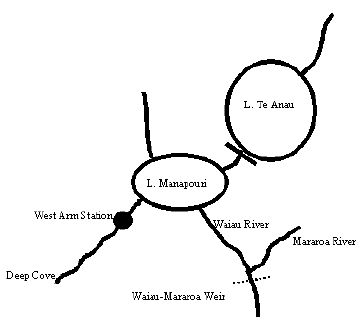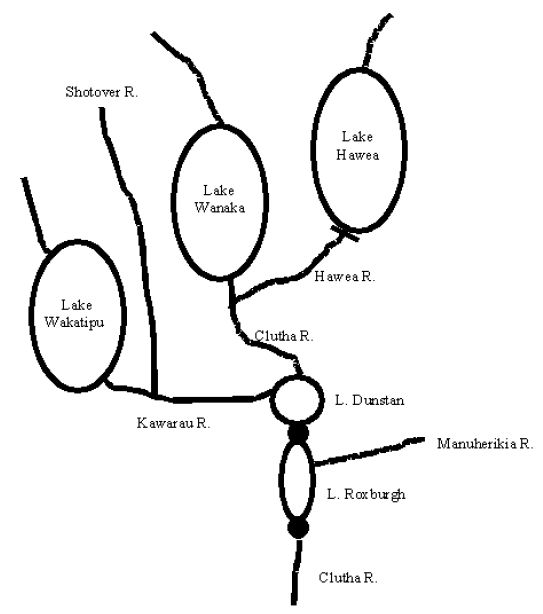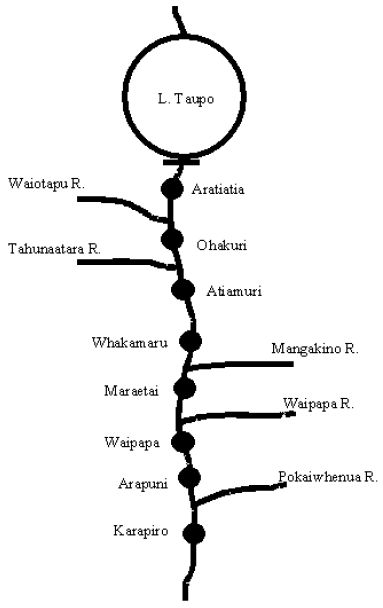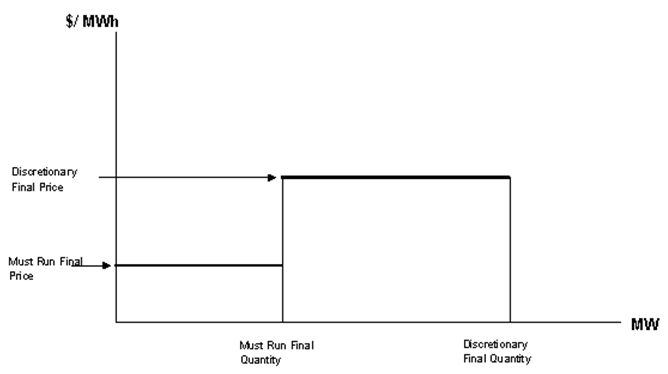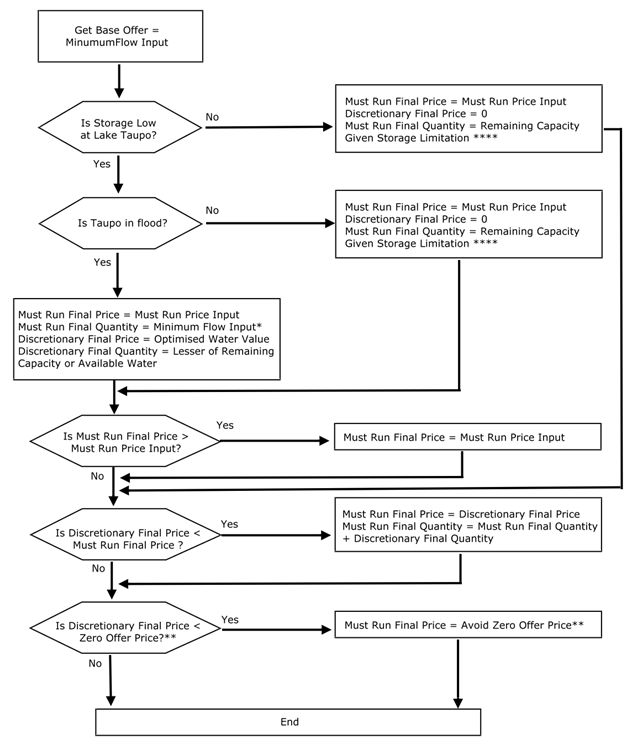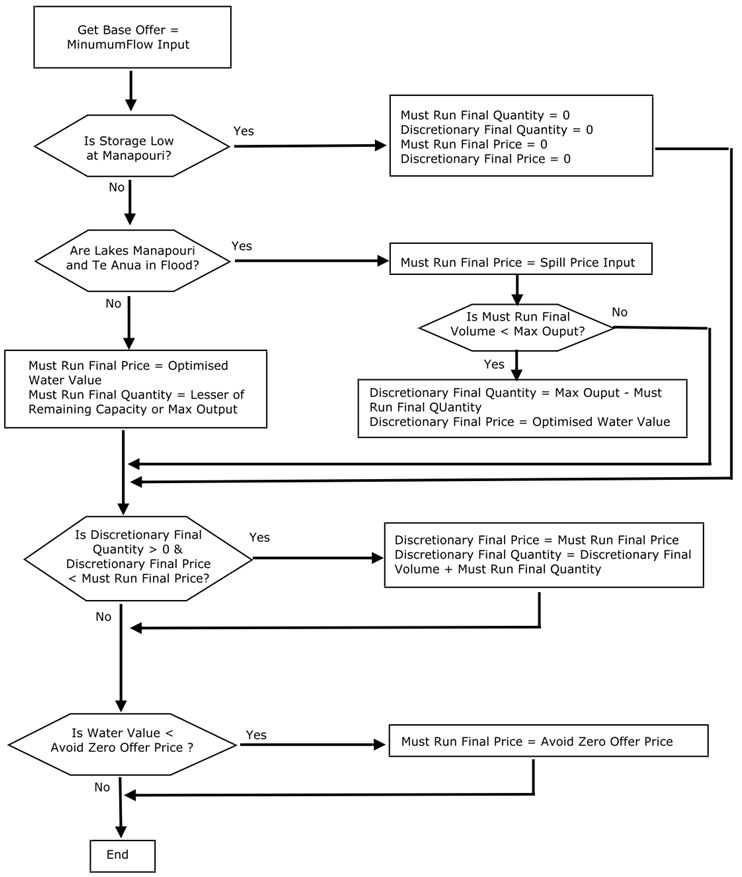Modelling Major Hydro Systems
As at April 2007
Disclaimer
Reasonable care has been taken to ensure that the information in this paper is up to date at the time of issue. Potential users of EMarket should, however, ensure that they evaluate EMarket and this paper through an appropriate evaluation process in consultation with Energy Link. The authors are also reliant on certain information external to EMarket and Energy Link, for which no liability or responsibility can be accepted.
Introduction
This technical bulletin is intended to provide users and interested parties with a detailed explanation of how EMarket’s four major hydro systems are modelled.
This paper includes a brief overview of other features in EMarket and a note on enhancements planned in the short to medium term.
Main Hydro Localisation
Each major hydro system may be represented by one more resources, and the appropriate resource used in each particular simulation run. In this way, each grid may have its own version of each of the main hydros. Each of these may be created as the thermal stations are but each of the main hydros has a separate category on the main screen. For example, you might want to run a simulation with a station added to a major hydro – in this case you would create a new resource of the hydro concerned, add the station, attach the resource to the grid you are using and do the run. This gives you a high degree of flexibility in how you model hydro systems.
The diagrams of the four major hydro systems in this technical bulletin show the default configurations but the user is able to change these, add or delete stations, in order to investigate upgrade or alternative scenarios, e.g. the addition of the now abandoned Project Aqua to the Waitaki hydro system.
In each of the separate hydro entities must run and spill prices and minimum flow are accessible. This facility allows the running of multiple configurations of the main hydros (see New Zealand Major Hydro Systems) without having to change the model's global variables.
Other Documents
This bulletin is one of a series of technical bulletins relating to Energy Link’s EMarket model. Taken together, the bulletins replace the old EMarket User Guide. The full series of bulletins covers an overview of the EMarket model, the details of the four major New Zealand hydro systems modelled in EMarket, water values and hydro offers, power flows, dispatch and nodal pricing, short term river chain optimisation and company optimisation.
Summary
IMPORTANT: The material in this section on offer formulation for the major hydro systems provides background information and relates primarily to the "old code" from v1.3.6.
The following is an overview of the operation and modelling of the main hydro systems. The level of detail has been deliberately chosen to give the user an appreciation of the offering and acceptance dispatch algorithms. It is not intended to detail in extenso the precise workings of each major hydro system's algorithm, nor is it intended to be a full account of the operation of the hydro systems in practice. Rather, it is intended to give the user an insight into the behaviour of the major hydro systems, both as modelled and in practice. Note that if a major hydro system uses Short term River Chain Optimisation then its smaller storages are modelled and its offers are calculated by the optimiser rather than as described here.
In each of the following sections an overview of the system is given, with a diagram showing the principle parts. The key for these is shown on the Waitaki diagram. This is followed by an explanation of the algorithms used to model the offers and post dispatch evaluation. Unless otherwise stated, the information used to put together the major hydro models is taken from resource consent applications, brochures and other sources of information in the public domain.
Note that, in all cases, flow delays are ignored, thus avoiding the need to include inter-period hydro modelling in EMarket.
Manapouri
The Manapouri hydro-electric system consists of two storage lakes in series, Te Anau and Manapouri, a hydro-electric station at West Arm of Lake Manapouri and two parallel tail race tunnels to Deep Cove on the West Coast. The two lakes are linked by the Upper Waiau River with discharges from the system occurring either through the tail race at Deep Cove or through the Waiau-Mararoa control structure into the Lower Waiau River.
Minimum flows in the Lower Waiau River are required and include normal minimum flows, recreational, flushing and river mouth opening flows. Only the minimum flows are modelled, which captures 89% of the average annual loss in GWh.
The operation of the lakes themselves are constrained by the Guidelines agreed between the Guardians of Lakes Manapouri and Te Anau and ECNZ. These Guidelines are restrictive and specify inter alia how long the lakes may remain at any given level and the interval before returning to that level. The intention of these Guidelines is to mimic the natural rise and fall of the lakes in their uncontrolled state and thereby to preserve the shoreline ecology.
Since the ratio of storage to inflows is low and inflows are great, the station is virtually run of river and in practice is operated to use the inflows as they arrive. This produces a storage profile in EMarket that is close to natural without enforcing the Guidelines explicitly.
Aside from the above complications, the Manapouri system is quite simple. It is modelled as one storage lake, Manapouri in the inflows file, and one generator. Spill and must run flows both pass down the Waiau River.
Since the Manapouri system has no minimum generation requirement, (i.e. the minimum flow is not derived from a minimum generation as with most hydro systems) the must run price input is generally ignored in determining the offer.
One offer band is usually made which is at the current water value. If storage is too low then no offer is made but if storage is such that spilling is likely then two offer bands are used. The first offer band is the portion of storage which may be lost and is offered at the flood price, whilst the second, if any output remains, is offered as usual at the current water value.
Two further things may affect the offer: if the second band has a lower price than the first then the offers are combined at the lower price; if any offer price falls below a certain threshold then it is reset to the "avoid zero offer price." At present the "avoid zero offer price" is set to $1/MWh.
Waitaki
The Waitaki system is the most complex of the four main hydro electric systems in New Zealand. As can be seen from the following diagram, there is potential to use all of the inflows to the system in a relatively controlled manner compared with the Clutha system, for example. The Ohau River is not normally used in the course of generation since a release for generation flows down the adjacent canal, but flows are specified for summer and winter. The Tekapo and Pukaki rivers are normally dry.
The diagram shows storage lakes behind most of the stations in the system. Apart from Tekapo and Pukaki the storage is minimal. Ohau has some storage, about a dozen GWh at most, as does Benmore. However, Benmore's storage of 156 GWh is misleading in practice due to the requirements for a reasonably high head to retain efficiency in generation at Benmore and the requirement for a sufficiently high lake level so as not to inconvenience recreational users of the lake. The lakes at Aviemore and Waitaki are more in the nature of head ponds. All lakes except Tekapo and Pukaki are modelled with zero storage.
The system can be considered to consist of three parts in two ways: by the storage lakes of Tekapo, Pukaki and Ohau, or by the generation groups of Tekapo, Ohau and Lower Waitaki.
Lake Pukaki can hold the greatest amount of potential energy of any storage lake in New Zealand. It is important to note that flows from Tekapo which pass through Tekapo B station flow into Pukaki, thereby re-using Lake Tekapo water and increasing the inflows to Pukaki.
Lake Ohau has much less storage than Tekapo or Pukaki but due to its position in the hydro chain its water is worth the same energy per unit as water in Pukaki. Dividing the system by generation groups divides the total possible contribution to energy production approximately equally.
The offering algorithm works in the following way. Lake Tekapo's level is assessed and may fall into one of three categories: near to spilling, near to empty or at neither extreme. In the first case the release is set to the maximum canal flow, in the second case the release is set to zero. When the lake is at neither extreme a flag is set to indicate discretionary releases are possible and if the relative level of Tekapo is greater than Pukaki, Tekapo release is calculated to provide a minimum energy output from the system and to contribute to the minimum flow requirement down stream from the Waitaki station.
Lake Pukaki is then similarly assessed. If it is near to spilling then the release is set to equal the amount expected to be spilt, subject to meeting Waitaki minimum flows and allowing for the release from Tekapo and the uncontrolled flows in the Ahuriri River. In all cases, the maximum flows in the Pukaki canal exert an overall limit on the flow from Pukaki.
If Pukaki can meet the maximum canal flows for the length of the tick then the discretionary release flag is set to true and the initial release is set to whatever is required to meet the Waitaki minimum flow. If the lake is not capable of meeting the maximum canal flows then the release is set to zero, discretionary releases are not permitted and any further releases to meet the minimum flow are made from Tekapo.
The releases from this first stage are totalled to give the first, or must run, offer band. This offer is reduced to the flood price if either lake is, or is near to, spilling. If discretionary releases are permitted then either or both Tekapo and Pukaki's possible releases form the second offer band at the current water value. If the second offer is at a price less than the first offer then a combined offer is made at the lower price subject to not being lower than the "avoid zero offer price" of $1/MWh.
After dispatch, the algorithm first determines the generation from the uncontrolled inflows from Ahuriri and Ohau and the must run releases from Tekapo and Pukaki. If this quantity exceeds the dispatched amount then ipso facto some water must have been unused which is calculated in terms of equivalent spill from Pukaki.
Spill may also have been required to meet the minimum flow if the dispatched generation used less water than the minimum flow. If the dispatched generation is greater than the generation from the must run releases then, depending on the relative storage of Tekapo and Pukaki, releases are deemed to have been made from either or both of these lakes, as required to meet the amount of generation dispatched. These calculations are subject to the usual constraints of canal capacity.
Results of the tick are contained in the hydrological output file. Both spill and release are in cumecs equivalent to releases from Pukaki.
Clutha
The Clutha system comprises the following:
- the controlled storage of lake Hawea;
- two uncontrolled lakes, Wanaka and Wakatipu;
- two uncontrolled tributaries, Shotover and Manuherikia; and
- two hydro electric stations, Clyde and Roxburgh.
As uncontrolled lakes, the outflows from both Lakes Wanaka and Wakatipu are determined by their inflows and current storage. That is, the outflow over a period of time is a function of the starting storage and the inflows over that period. Lake Hawea, while controlled, has a minimum release of five cumecs as well as a maximum release of 200 cumecs, the latter being an informal arrangement to limit bank erosion. In practice, high flows in the Shotover can cause flows up the Kawarau toward Lake Wakatipu but this is not modelled due to its minor overall effects.
The two dams which form Lakes Dunstan and Roxburgh contain the Clyde and Roxburgh generation stations, respectively. Neither lake has a large amount of storage and consequently the storage is assumed to be nil in the model to reflect their status as head ponds.
Minimum flows apply downstream of each dam:
- At Clyde the requirement in 150 cumecs.
- At Roxburgh the minimum flow is 150 cumecs, equivalent to 60 MW generation, between September and April and the minimum flow is 100 cumecs which is equivalent to 40 MW generation, for the rest of the year.
These flows may be met by generating to release the water or by spilling at the dam.
Inflows to the system are assumed to be known with a high accuracy. This is due to the forecasting mechanisms in place in practice and the assumption that it is in the interest of the system operator to predict hydrological conditions well to maximise revenue and minimise spill. From these predicted inflows the expected outflow from the uncontrolled lakes is calculated.
Since only water in Hawea can be stored under direct control, any other flows in the system must be offered as must run generation. If Hawea is close to full and may spill then the portion which might be spilt is added to the must run offer. If storage is low only the minimum release is permitted, if possible. When Hawea is at neither extreme the minimum release is added to the must run offer and further releases are made available for the discretionary offer.
The quantity in the first offer band is calculated by adding the release from all sources upstream of Clyde, multiplying it by the MW per cumec for Clyde, then adding the flow from the Manuherikia River and multiplying it by the MW per cumec for Roxburgh. This is offered at the must run price except when Hawea is close to spilling in which case it is offered at the flood price.
The second offer is only calculated if discretionary releases from Hawea are permitted. If this is so an offer is determined subject to the maximum release and maximum usable flows at both dams. If the current water value is less than the must run price then the two offers are totalled and are offered in at the lower price, subject to not being lower than the "avoid zero offer price" of $1/MWh.
After dispatch a check is made to see if the dispatched generation can be met by the uncontrolled flows. If further releases are required these are taken from Hawea. When generation is more than covered by the sum of uncontrolled flows and the minimum release from Hawea, then spill occurs. The release and spill amounts in the hydrological output file are in equivalent cumecs at any of the sources except the Manuherikia, since all sources except Manuherikia have the same MW per cumec for the system.
Note that in times of high inflows and low demand it is not uncommon to see high spill figures for the Clutha system combined with releases from Hawea. This is usually due to either the minimum release at Hawea being enforced or a requirement to release more water than usual because of high lake levels.
Waikato
The Waikato hydro electric system can be thought of as a single chain of stations stretching from Lake Taupo to Karapiro with a handful of tributaries along its length.
The Waikato system also receives inflows from the Tongariro Power Development, comprising the Rangipo and Tokaanu stations, into Lake Taupo. These flows must be added to the natural inflows to Taupo. It is of note that the minimum flow at Karapiro was set after considering the effect of flows from "foreign catchments". Since then the allowable diversion into the Tongariro Power Development has been reduced leaving the Waikato system with a more onerous task of maintaining the Karapiro minimum flow.
At the other extreme, the system also appears more prone to flooding and flow constraints than the other main hydro systems. For this reason the flood rules have been implemented at Lake Taupo. These are a set of rules which specify the release of water from Lake Taupo at the Taupo control gates and are a function of the level of the lake and the time of year, where the time of the year relates to the probability and size of the "flood" inflow. They attempt to balance the retention of water in Taupo, to reduce flooding effects downstream, with the limits of storage in the lake which, if breached, lead to lake shore erosion, flooding in the vicinity and a statutory obligation to compensate for the damage.
If the flood rules should apply then the release is assumed to follow the table strictly, that is to say there is no discretionary release. The offer price of a release in compliance with the flood rules is the must run price, unless the current water value is lower. Where the current water value is lower the offer is made at that price, subject to it not being lower than the "avoid zero offer price" of $1/MWh. However, it should be noted that when the flood rules apply the storage is very likely to be at the upper reaches of the water value contours and consequently the offer may be at or near the "avoid zero offer price" anyway.
Apart from the flood rules there is a minimum flow at the Taupo Gates. There is also a limit on the rate of change of flows at Karapiro although this is not modelled. There appears to be no other minimum flow limits on any other parts of the Waikato. As usual there are head ponds behind each station which are modelled as having no storage.
An additional complication is the Aratiatia Rapids. Water from Taupo is spilt into the rapids, past the Aratiatia station and on to Ohakuri. This is done several times a day for a set period of time. An allowance is made at Aratiatia for the lost generation in the system.
The offer algorithm starts by testing for the conditions for the flood rules to apply. If they do not, then water is released from Taupo to meet the minimum flow at Karapiro allowing for the five tributary flows. This is subject to meeting the minimum flow at the gates and there being sufficient water in Taupo. If storage is low then a flag is set to indicate there will be no discretionary offer.
The offer quantity is derived by determining the flow at each station and calculating the implied output in MW subject to the maximum output of each station. This total becomes the quantity of the first offer band. The price is provisionally set to the must run price. If the must run price is less than the current water value then all offers are made at the current water value, subject to it not being less than the "avoid zero offer price".
When a discretionary offer is permitted the remaining portion of generation capacity is offered in subject to availability of storage in Taupo. As with the other hydro systems if the second band should have a lower price than the first band then both offer quantities are offered at the lower price, subject to the price not falling below the "avoid zero offer price" of $1/MWh.
Once the system has been dispatched the actual inflows for the tick are determined and the generation from the tributary or uncontrolled flows calculated. Generation from the required release from Taupo is added to obtain the base generation. If the base generation implied by the required releases is more than the dispatched generation then there must have been some unused water in the chain. This is calculated as spill in cumecs equivalent to water stored in Taupo and is shown in the hydrological file. There is always some spill at Taupo due to the water released for the Aratiatia Rapids.
When further releases are required to meet the dispatched generation, water is released from Taupo until the total generation is met. The release required is calculated by iterating as each station constrains at maximum output at a different flow, so that there are diminishing returns as the release increases. It is assumed that delays in water released becoming available at all stations are negligible. This is due to the longer modelling periods usually used and the use of the head ponds as a buffer to changes in release at the Taupo Gates.
Summary of Major Hydro Pricing
The following flow charts show how the pricing mechanism operates in the modelling of major hydros. Overall, Waikato, Waitaki and Clutha behave in the same way when it comes to setting an offer price, however, Manapouri is slightly different.
The following chart is a simplified representation of the two main prices used in the pricing of major hydros. However, as the flow charts show, both the must run final price and the discretionary final price are very much dependent upon the storage. For further information on how hydro offers are formulated refer to Water Values and Hydro Offers
The following flow chart is applicable to the Waikato, Clutha and Waitaki systems:
* Minimum Flow Input is an input figure in cumecs. This is then converted to MW but the quantity of MW may vary depending which catchment the water has originated from.
** Avoid Zero Offer Price is a hard code input which is offered in the event of the optimised price being $0/ MWh. Zero Prices affect the dispatch algorithm.
***Flood Release is the quantity required to be released in order to obey the flood rules.
****Storage limitations as outlined in the Resource Consent.
The following flow chart is applicable to the Manapouri system.
Internal Main Hydro Variables
Each of the main hydros has variables which can be edited by the user and variables which can be changed during a run via the scheduler (see Schedules)
| Variable Name | Editable | Schedule Identifier | Units or Type |
|---|---|---|---|
| Description | Yes | ||
| Marginal Cost | Yes | $/MWh | |
| Flood Price | Yes | fp | $/MWh |
| Flood Level % Full | Yes | % | |
| Must Run Price | Yes | mrp | $/MWh |
| Minimum Flow Variable fraction | mfv | real such that 0 mfv 1 | |
| Release Offers | Yes | $/MWh and % | |
| Total Release | rel | binary variable (0 or 1) | |
| Variable Release fraction | relv | real such that 0 relv 1 | |
| Use extreme band | Yes | On/Off | |
| Extreme Band Price | ExtP | $/MWh | |
| Variables per Station | |||
| Min Flow | Yes | MinFlow | Cumec |
| Max Output | Yes | maxMW | MW |
| Efficiency | Yes | MWperCumec | MW/cumec |
| Max Spill | Yes | Cumec | |
| Storage | Yes | Cubic m |
Note that Manapouri does not have a must run price as outlined in its own section above. System-wide efficiency and max output are calculated from the sum of station variables. Offer-related variables are not applicable if a hydro uses short term river chain optimisation. Scheduled changes to station variables are only applied if using short term optimisers.
The must run and flood prices, function as outlined in the previous sections. The ability to set these in the schedule allows variation over time for a given run. However, it should be noted that these values do not normally need to change over a run.
Both the variables, mfv and relv, permit the reallocation of the quantity from the night to the day. For example, if the release or minimum flow is 200 MW or cumecs respectively, then a variable quantity of 0.6 would set the day amount to 250 and the night to 100. The mfv formulae (see the Schedule section in the User Manual), allocates the minimum flow to day and night periods. A value of 1 allocates all of the quantity to the day, while setting either mfv or relv to zero leaves the day and night equal.
The variation in the fixed values which these variables allow, permits the modelling of day and night variation in release or minimum flow. If the usual method of releasing a minimum flow and using the water value to price the discretionary offer is used, then the variation may be obtained through the mfv variable. In this case, the hydro system will make its first offer using the altered minimum flow as a guide. The effects of this on the hydro systems can be determined from the previous sections outlining the main hydro systems. This altered minimum flow is subject to the same restrictions as the usual minimum flow, including minimum lake levels and being likely to spill. Note that the value being changed is cumecs.
To vary the releases between night and day, the release variable (rel) must first be set to 1 to indicate that the release contours are to be followed for the indicated main hydro. The operation of these contours is explained in section 19.10 of The User Manual. If release contours are being used, then the relv variable permits day and night variation in the total release in MW. However, this only applies to the discretionary portion of the release. That is, an optimal release in MW is calculated and the must run or first offer is subtracted from it. The remaining release is then allocated to the night and day in line with the relv variable.
The extreme band price is the price at which a band after the must run and other offer bands from the release contour calculations will be offered. Note that entering a price here will over-ride the main hydro option, that is, even if the option is not selected on the main hydro screen but a price is given in the schedule, then the extreme offer will be made.
